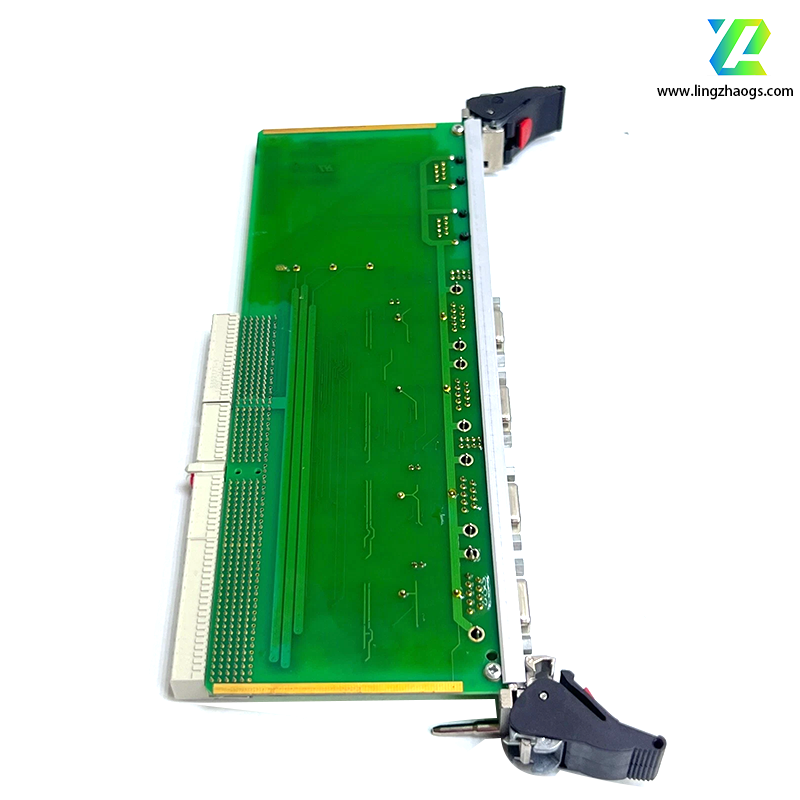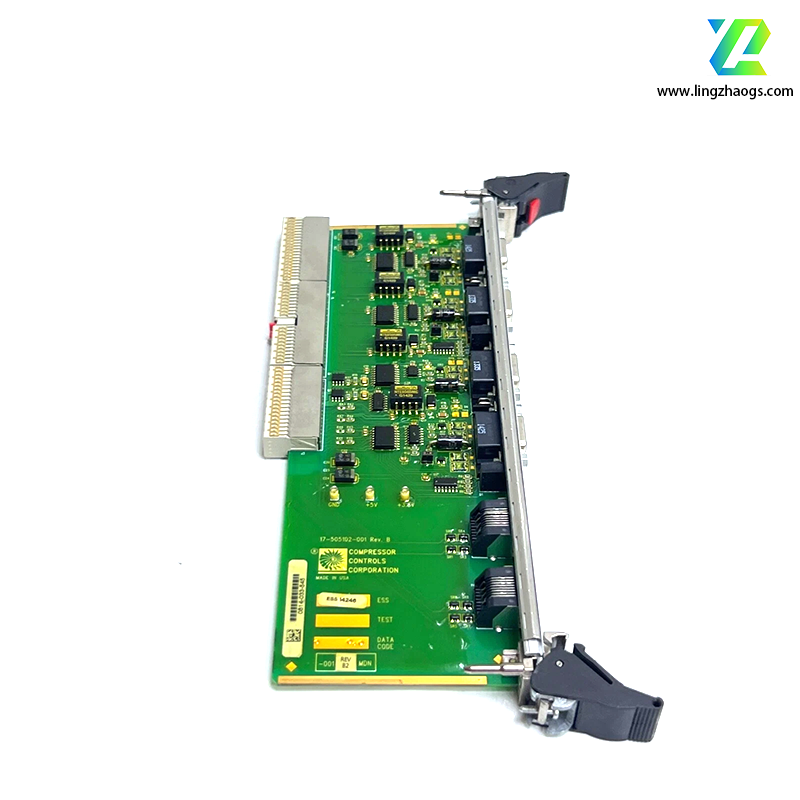CCC Compressor Controls Corp
- Product Name: CCC TMPU-1002 Turbine Monitoring and Protection Unit
- Product Categories: CCC Compressor Controls Corp
- Contact: 13394046250
- Company Name: Xiamen Lingzhao
- Company Address: Phase III of Software Park, Jimei District, Xiamen City, Fujian Province
- Add Time: 2025-10-22
Details
Here’s a detailed overview of CCC TMPU-1002 (Compressor Controls Corporation part number) based on industrial control system references, third-party distributor data, and CCC’s product focus on turbomachinery monitoring and control. As a specialized turbine module, this part aligns with CCC’s core offerings in optimizing gas/steam turbine performance and safety for oil & gas, petrochemical, and power generation applications. For official specifications, consult Compressor Controls Corporation (CCC) directly.
- Brand: CCC (Compressor Controls Corporation)
- Model: TMPU-1002
- Type: Turbine Monitoring and Protection Unit
- Industry: Oil & gas, petrochemicals, power generation, and industrial manufacturing.
- Function: Serves as a dedicated monitoring and protection module for gas, steam, or hydro turbines. It continuously tracks critical turbine parameters (e.g., speed, vibration, bearing temperature, exhaust gas temperature) to detect abnormal conditions. When thresholds are exceeded, it triggers alarms or initiates safety interlocks (e.g., emergency shutdown) to prevent equipment damage or catastrophic failure. Unlike general-purpose I/O modules, it integrates turbine-specific protection logic tailored to CCC’s control systems.
Turbine-Critical Parameter Monitoring
- Preconfigured to monitor core turbine health and operational parameters:
- Speed Monitoring: Interfaces with magnetic pickup (MPU) sensors or optical encoders to track shaft speed (supports 0–10 kHz frequency inputs), with overspeed detection (e.g., 115% of rated speed) as a primary protection function.
- Vibration & Position: Compatible with proximity probes (e.g., Bently Nevada 3300 Series) for radial/axial vibration and rotor position measurements, critical for detecting unbalance or misalignment.
- Temperature Monitoring: Accepts RTD (PT100/PT1000) or thermocouple (Type K/J) inputs for bearing, lube oil, and exhaust gas temperature (EGT) measurements.
- Pressure & Flow: Integrates 4–20 mA signals from pressure transmitters (e.g., lube oil pressure) and flow meters (e.g., fuel flow).
Hardwired Safety Interlocks
- Features independent hardwired protection circuits (separate from software logic) for critical safety functions like overspeed, low lube oil pressure, or high bearing temperature. This “fail-safe” design ensures interlocks activate even if the main control system malfunctions.
- Configurable alarm/shutdown thresholds (e.g., 200°C for bearing temperature, 0.8 bar for minimum lube oil pressure) via DIP switches or CCC software, adapting to different turbine models.
Real-Time Data Processing & Diagnostics
- Equipped with a dedicated microprocessor for high-speed data acquisition (sample rates up to 1 kHz per channel) and real-time analysis of turbine conditions.
- Built-in diagnostic features include sensor fault detection (e.g., open-circuit RTD, shorted thermocouple), module self-test, and event logging (stores last 100 fault events with timestamps for post-incident analysis).
System Integration & Redundancy
- Communicates with CCC’s main control systems (e.g., Omnex T6000/T7000) and HMIs via proprietary CCC protocols and standard industrial protocols (e.g., Modbus RTU/TCP) for centralized monitoring.
- Supports 1:1 hot redundancy (common in critical turbine applications). A backup TMPU-1002 mirrors the primary unit’s operation; if the primary fails, the backup takes over seamlessly to maintain protection coverage.
Electrical Parameters
- Power Supply: 24V DC (standard for CCC control modules), with a tolerance range of 18–32V DC.
- Power Consumption: ≤15W under full load (varies with active sensors and redundancy status).
- Input Channels (Typical):
- Speed Inputs: 2 channels (redundant MPU/encoder inputs for overspeed detection).
- Vibration/Position Inputs: 4 channels (proximity probe inputs, 500 mV/mm sensitivity).
- Temperature Inputs: 8 channels (RTD: PT100/PT1000; Thermocouple: Type K/J).
- Analog Inputs (Pressure/Flow): 4 channels (4–20 mA, ±0.1% accuracy).
- Digital Inputs (Status): 6 channels (24V DC dry contact for valve position, pump status).
- Outputs:
- Relay Outputs: 4 channels (2A @ 250V AC) for alarms (e.g., high vibration) and shutdown signals (e.g., overspeed trip).
- Digital Outputs: 2 channels (24V DC open-collector) for diagnostic alerts.
Physical & Environmental Attributes
- Form Factor: Rack-mount design (compatible with CCC’s 19-inch control cabinets), 1 rack unit (U) high.
- Dimensions: Approximately 483 mm (width) × 44 mm (height) × 180 mm (depth) (estimated for 1U form factor).
- Environmental Ratings:
- Operating Temperature: -20°C to +60°C (suits indoor control rooms and climate-controlled turbine enclosures).
- Humidity: 5–95% (non-condensing), resistant to moisture in industrial settings.
- Vibration/Shock: Compliant with IEC 60068-2-6 (vibration, 5–500 Hz) and IEC 60068-2-27 (shock, 50g peak acceleration) for durability near rotating equipment.
Safety & Compliance
- Safety Integrity Level (SIL): Likely rated SIL 2 (per IEC 61508) for safety interlock functions, ensuring reliable protection against hazardous turbine conditions.
- Certifications: Compliant with IEC/EN 61010-1 (industrial measurement equipment safety) and UL 508 (industrial control equipment).
- Turbine Protection:
- Primary protection module for gas turbines in natural gas processing plants, steam turbines in power generation, and hydro turbines in renewable energy facilities.
- Monitors overspeed, low lube oil pressure, high bearing temperature, and excessive vibration to trigger pre-alarms or emergency shutdowns (ESD).
- Turbine Health Monitoring:
- Feeds real-time data (e.g., EGT, vibration spectra) to CCC’s main controllers and SCADA systems for predictive maintenance, helping identify issues like bearing wear or rotor imbalance before failures occur.
- Auxiliary System Control:
- Integrates with turbine auxiliary systems (e.g., lube oil pumps, fuel valves) to monitor their status and activate backups if primary components fail (e.g., start standby lube oil pump on low pressure).
- Condition: Available as new OEM (through CCC directly) or genuine refurbished (via authorized industrial automation distributors, e.g., EquipNet, Industrial Control Service).
- Warranty: 12-month warranty for new units (covers defects in materials/workmanship); refurbished units typically include a 6-month warranty.
- Documentation:
- Technical datasheets, wiring diagrams, and configuration guides are restricted to CCC’s authorized customers. Request official materials via CCC’s customer portal.
- Third-party distributors may provide basic installation notes and compatibility checks for integration with CCC Omnex systems.
- Compatible Systems:
- CCC Omnex T6000/T7000 Turbine/Compressor Control Systems.
- CCC Main Controllers (e.g., MCP-1004), I/O Modules (e.g., TIOC-555HD), and Power Supplies (e.g., PSMU-350-3).
- Turbine sensors (MPUs, proximity probes, RTDs/thermocouples) and safety valves.
- Similar CCC Models:
- CCC TMPU-2002: Advanced variant with additional channels (e.g., 8 vibration inputs, 12 temperature inputs) for large-scale turbines.
- CCC TMPU-1001: Basic turbine monitoring unit (no hardwired safety interlocks, for non-critical applications).
- Setup Requirements:
- Mount in a 19-inch rack with 1U clearance; install near the turbine control cabinet to minimize sensor wiring length (critical for signal integrity, especially for vibration/speed inputs).
- Configure via CCC’s proprietary software (e.g., CCC Control Studio) to set alarm/shutdown thresholds, map sensor inputs to outputs, and enable redundancy.
- Wiring Guidelines:
- Use shielded, twisted-pair cables for speed and vibration inputs to reduce EMI/RFI interference. Ground shields at the module end only to avoid ground loops.
- For hardwired safety interlocks (e.g., overspeed trip), use redundant wiring paths to the turbine’s emergency shutdown system (ESS) for maximum reliability.
- Safety & Troubleshooting:
- Follow lockout-tagout (LOTO) procedures when wiring or servicing the module—incorrect configuration of safety interlocks can disable turbine protection.
- Use front-panel LED indicators to diagnose status:
- Steady green: Normal operation.
- Flashing yellow: Pre-alarm (e.g., high bearing temperature approaching threshold).
- Steady red: Critical fault (e.g., overspeed, module failure).
- For sensor faults, use a multimeter to verify continuity and signal integrity; common issues include loose connections or damaged sensors (e.g., broken MPU wiring).
- Model Functionality: The “TMPU” (Turbine Monitoring and Protection Unit) designation confirms this module is for turbine-specific protection, not general-purpose monitoring. It cannot be substituted with standard I/O modules for safety functions.
- Redundancy Configuration: Redundant operation requires two identical TMPU-1002 modules and a CCC redundancy interface module (e.g., RCM-01). Improper pairing or firmware mismatch will prevent failover.
- Genuine Parts & Calibration: Use genuine CCC TMPU-1002 modules for safety-critical applications. Aftermarket units may not meet SIL 2 requirements. Additionally, calibrate analog/temperature channels annually (per CCC guidelines) to maintain measurement accuracy.
For further technical assistance, contact Compressor Controls Corporation’s global support team or your local authorized service provider. Always validate specifications against your turbine’s protection requirements and control system compatibility before installation.



